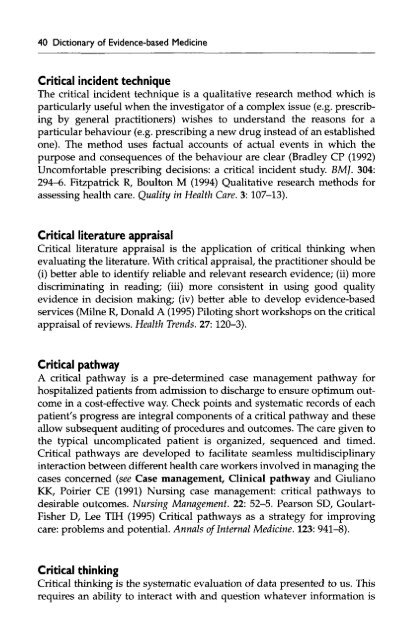Dictionary of Evidence-based Medicine.pdf
Dictionary of Evidence-based Medicine.pdf
Dictionary of Evidence-based Medicine.pdf
You also want an ePaper? Increase the reach of your titles
YUMPU automatically turns print PDFs into web optimized ePapers that Google loves.
40 <strong>Dictionary</strong> <strong>of</strong> <strong>Evidence</strong>-<strong>based</strong> <strong>Medicine</strong><br />
Critical incident technique<br />
The critical incident technique is a qualitative research method which is<br />
particularly useful when the investigator <strong>of</strong> a complex issue (e.g. prescribing<br />
by general practitioners) wishes to understand the reasons for a<br />
particular behaviour (e.g. prescribing a new drug instead <strong>of</strong> an established<br />
one). The method uses factual accounts <strong>of</strong> actual events in which the<br />
purpose and consequences <strong>of</strong> the behaviour are clear (Bradley CP (1992)<br />
Uncomfortable prescribing decisions: a critical incident study. BMJ. 304:<br />
294-6. Fitzpatrick R, Boulton M (1994) Qualitative research methods for<br />
assessing health care. Quality in Health Care. 3: 107-13).<br />
Critical literature appraisal<br />
Critical literature appraisal is the application <strong>of</strong> critical thinking when<br />
evaluating the literature. With critical appraisal, the practitioner should be<br />
(i) better able to identify reliable and relevant research evidence; (ii) more<br />
discriminating in reading; (iii) more consistent in using good quality<br />
evidence in decision making; (iv) better able to develop evidence-<strong>based</strong><br />
services (Milne R, Donald A (1995) Piloting short workshops on the critical<br />
appraisal <strong>of</strong> reviews. Health Trends. 27: 120-3).<br />
Critical pathway<br />
A critical pathway is a pre-determined case management pathway for<br />
hospitalized patients from admission to discharge to ensure optimum outcome<br />
in a cost-effective way. Check points and systematic records <strong>of</strong> each<br />
patient's progress are integral components <strong>of</strong> a critical pathway and these<br />
allow subsequent auditing <strong>of</strong> procedures and outcomes. The care given to<br />
the typical uncomplicated patient is organized, sequenced and timed.<br />
Critical pathways are developed to facilitate seamless multidisciplinary<br />
interaction between different health care workers involved in managing the<br />
cases concerned (see Case management, Clinical pathway and Giuliano<br />
KK, Poirier CE (1991) Nursing case management: critical pathways to<br />
desirable outcomes. Nursing Management. 22: 52-5. Pearson SD, Goulart-<br />
Fisher D, Lee TIH (1995) Critical pathways as a strategy for improving<br />
care: problems and potential. Annals <strong>of</strong> Internal <strong>Medicine</strong>. 123: 941-8).<br />
Critical thinking<br />
Critical thinking is the systematic evaluation <strong>of</strong> data presented to us. This<br />
requires an ability to interact with and question whatever information is










